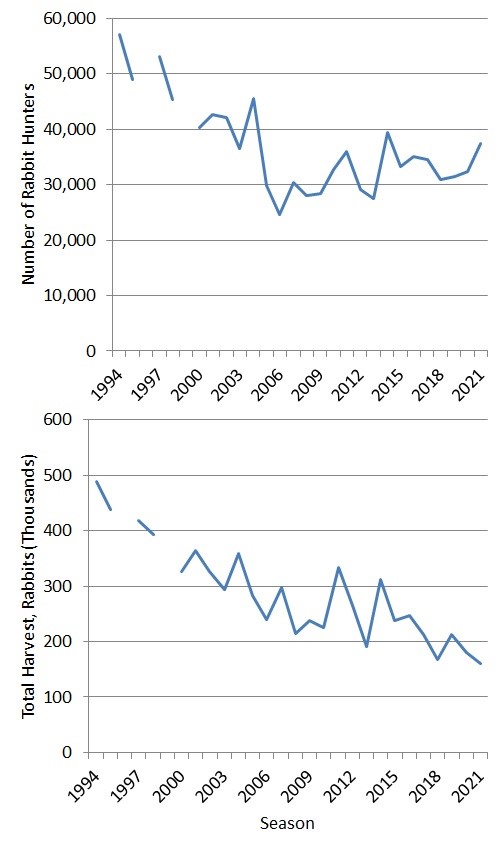
If you have questions about purchasing a license call 1-800-5GO-HUNT.
There are two species of rabbits found in Mississippi, the cottontail rabbit (sometimes called a hillbilly) and the swamp rabbit (sometimes called a cane-cutter). Both species are relatively common to all regions of the state, but cottontails are probably the most widely distributed and most numerous. Like quail, declining rabbit populations have been mostly due to changes in land use and management. Despite the loss of habitat and declining rabbit populations, local rabbit populations can be increased with planned habitat management at proper scales. Habitat management practices that produce the proper cover resources required by rabbits are essential to increase local rabbit populations.
There are a number of public lands that are open to rabbit hunting in Mississippi, including Wildlife Management Areas (WMAs), National Forests, National Wildlife Refuges, and U.S. Army Corps of Engineers Lakes and Tenn-Tom Waterway. The presence and abundance of rabbits on these areas vary depending on habitat quality and quantity. Cottontails can be found in upland and lowland areas while swamp rabbits are typically found around wetlands, rivers, creeks, and other lowland areas. Both species require an abundant mix of upright grass cover, broadleaf plants, and brushy thickets. Some areas are managed with an emphasis on habitats that are more favorable for rabbits, including Black Prairie, Charles Ray Nix, and Hell Creek WMAs. Trim Cane WMA (near Starkville) offers rabbit hunting through a special permit process. Permit applications are available August 1 to August 31. A limited number of permits are issued by a random drawing of applications. A Wildlife Management Area User Permit (may be purchased anywhere hunting licenses are sold) is required of anyone hunting on a WMA, unless exempt from purchasing a hunting and fishing license. Always check area regulations from the appropriate administrative agency for open season dates, bag limits, and additional permit requirements.
The MDWFP has conducted random, statewide surveys of hunting license holders almost yearly since the early 1980s (with some periodic surveys prior to that). The data below are from these surveys conducted since the 1980 - 1981 hunting seasons.

Figure 1. Trends in rabbit harvest estimated from surveys of licensed, resident hunters ("Season" indicates season opening date year).

Figure 2. Trends in rabbit harvest estimated from surveys of licensed, resident and non-resident hunters ("Season" indicates season opening date year). Data for non-resident hunters were not available prior to the 1994 - 1995 season.
Data Sources:
Hunt, K. M. 2012. Trends in Resident and Non-resident Hunter Effort and Harvest for Rabbit in Mississippi: 1980-81 to 2010-11 Seasons. Human Dimensions and Conservation Law Enforcement Laboratory Technical Document # 133, Mississippi State University, Mississippi State, MS.
Responsive Management. 2012-2021. Mississippi Resident and Nonresident Hunter Harvest Survey, Harrisonburg, VA.
The links below provide information about practices or programs that may be used to enhance rabbit and other wildlife habitat. Technical guidance from wildlife biologists is also available to provide advice on managing land for rabbit habitat. The MDWFP does not have a program to restock rabbits. Select the publication title to view material. Some of the links provided may direct you to web pages outside of the Mississippi Department of Wildlife, Fisheries, and Parks website.
Ecology and Management of Rabbits in Mississippi : A guide to rabbit ecology and management, including descriptions of life history, habitat requirements, habitat management practices, and harvest management. Published by the Mississippi State University Extension Service.
Strip Disking and Other Valuable Bobwhite Quail Management Techniques : A guide to strip-disking for bobwhite habitat management. Strip-disking is also a useful management tool for increasing availability of native plants that rabbits feed upon. Published by the Mississippi State University Extension Service.
Prescribed Burning in Southern Pine Forests: Fire Ecology, Techniques, and Uses for Wildlife Management : A guide to using prescribed fire for wildlife management. Published by the Mississippi State University Extension Service.
Legal Environment for Forestry Prescribed Burning in Mississippi : A guide to laws and legal considerations pertaining to prescribed burning in Mississippi. Published by the Mississippi State University Forest and Wildlife Research Center.
Supplemental Wildlife Food Planting Manual for the Southeast : A guide to plant materials and food planting strategies for wildlife food plots. Published by the Mississippi State University Extension Service.
Conservation Reserve Program, CP33 - Habitat Buffers for Upland Birds Video : This video explains the habitat and economic benefits of CP33 buffers for bobwhite quail and other wildlife. Select the "CP33 - Habitat Buffers for Upland Birds" video. This video was produced by the Mississippi State University Office of Agricultural Communications.
Native Warm-season Grass Restoration in Mississippi : A guide to releasing or establishing native warm-season grasses for wildlife habitat and livestock forage. Published by the Mississippi State University Extension Service.
Rick Hamrick
Email: rick.hamrick@wfp.ms.gov
Wildlife Bureau
Phone: +1 601-432-2199